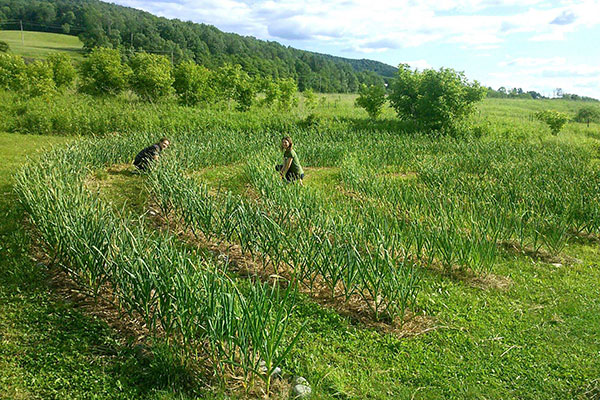The movement to be more sustainable and to ‘go green’ has finally become a priority in many areas of the world. It has encouraged thousands of people to reevaluate the choices they are making and the many rippling impacts that those choices have. Many are demanding changes to the economy and industries that they purchase from to help them achieve sustainability goals.
One essential industry that has experienced some of these impacts is agriculture. Environmentally-minded people recognize the imperativeness of food production, but they also see the powerful impacts that an industrialized agricultural community can create. In response, many are choosing sustainable career paths and searching for solutions that not only alleviate some of the most significant environmental impacts, but also provide the quantities of food necessary to support the world’s humans.
Perhaps the most profound benefit of the regenerative agriculture movement in the agricultural sector is related to soils. Organizations like Kiss the Ground are dedicated to regenerative practices that improve soil quality and quantity. These are big issues in agriculture, especially since many of the mainstream practices don’t do much to preserve or maintain them. Regenerative agricultural practices can be a means of reducing soil loss, building soil structure, and limiting the number of chemicals in soils. They advocate for a return to practices akin to Indigenous peoples’ ways of farming that preserve local ecosystems and maintain balance.
Preventing Loss
Soil loss and erosion are two of the most serious issues that the vast majority of civilization doesn’t realize its facing. An estimated 75 billion tons of soils are eroded each year from arable lands at an estimated cost of over $400 billion. Ultimately, this has rendered hundreds of thousands of acres of previously valuable farmland useless and the people who depend upon the crops helpless to survive without moving on to literally greener pastures.
Creating these greener pastures is just another step on a winding staircase that leads back to the same problems. Deforestation, particularly the removal of healthy forests that hold soils in place for the production of cash crops such as palm oil, pineapples, cotton, soybeans, and wheat, can seem like a great option for a few years. However, the soils are quickly depleted and the cycle starts once again, leaving barren areas to recover the best they can.
Regenerative agricultural practices aim to avoid this issue altogether. Rather than planting only cash crops that drain the nutrients out of the soil quickly and leave it depleted, farmers who use regenerative practices aim to plant on a rotation basis with cover crops that hold soil in place planted in between. The variety of plants that take different elements from the soils, while keeping crops on the land when not in production, can help limit both wind and water erosion.
Building and Remediating
Beyond simply holding the soils in place, planting cover crops can also play a major role in building soils and keeping them healthy for a long time, which is another goal of those in regenerative agriculture. Cover crops can be tilled into the soil when it comes time to plant. As they break down, they provide nutrients for the agricultural products grown there.
Planting using a monocultural practice—or planting the same crops in the same plot of land every year—reduces productivity over time. This is largely because nutrients are being depleted at a much faster rate. Even simple rotations of two or three crops can eventually negatively impact soils. More complex rotations prolong and even improve the health and quality of soils.
The major factors that make soils healthy though are the microorganisms that live within them. After all, soil differs from dirt in that soil is alive with a variety of microscopic beings living in it. These tiny organisms break down organic material into nutrients that are usable by plants—more material eventually means more nutrients and healthier soils. The process is crucial to the growth and production of anything growing in the soil.
Chemical Reduction
One of the other major soil concerns associated with most industrial agricultural practices is the intense use of chemical herbicides and pesticides. These chemicals control some of the most visible pests in agriculture, but at a stark invisible cost. Many treatments kill not only the pests, but also the beneficial organisms as well, such as those that help break down organic material.
Luckily, some solutions are becoming available to help these beneficial organisms be more effective. For example, Pheronym was inspired by the elegant chemical language that nematodes use to communicate, and thus created a biomimicry-inspired pest control that promotes healthy soil, healthy farmers, and healthy food. By tapping into the nematodes’ natural communication platform (pheromones) and telling nematodes to be more effective and efficient predators, they are allowing for a widespread adoption of a proven organic farming technique.
Many of the harmful chemicals have much more dispersed impacts, making a stronger case to adopt these more organic farming techniques. For instance, chemical fertilizers and herbicides can leach from the soil during big rainstorms and travel into waterways. The buildup of these chemicals can lead to all sorts of environmental issues such as algal growth, impacts to fish and invertebrate reproductive health, water temperature increases, and even a reduction in the availability of quality drinking water. Poor water quality not only ruins crops, it risks human health, increasing chances for diseases such as e. Coli, giardiasis, and hepatitis.
More regenerative agricultural practices typically aim to limit the number of chemicals needed for production. Many do away with them altogether and instead opt for more natural solutions to pests and weeds. Some alternatives include strategies like increasing crop rotation to prevent infestations, interplanting species that pests naturally avoid, or using a variety of mechanical treatment methods.
***
The world is eager for change, for a more environmentally sound future. Regenerative agricultural practices can play a role in improving soils, which are a major factor. And the ecosystem effect, mutualism in support of all Life, and closed-loop processes are all essential components of biomimicry. Practices such as limited planting of new land clearing, planting cover crops, promoting healthy soil microorganisms, and reducing chemical usage are great means of beginning this journey.
Ultimately, it’s up to us humans to shift our perspective in how we view the land that we take from and how we can design better systems that are balanced and support regeneration of our shared Earth.
 Adrian Johansen loves to learn and share knowledge. You can find more of her writing on twitter and contently.
Adrian Johansen loves to learn and share knowledge. You can find more of her writing on twitter and contently.

